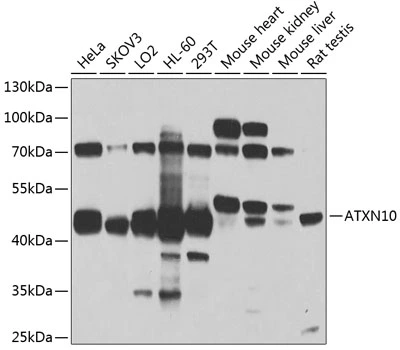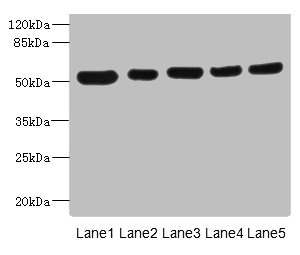ATXN10 antibody
GTX105440
ApplicationsWestern Blot, ImmunoHistoChemistry, ImmunoHistoChemistry Paraffin
Product group Antibodies
TargetATXN10
Overview
- SupplierGeneTex
- Product NameATXN10 antibody
- Delivery Days Customer9
- Application Supplier NoteWB: 1:500-1:3000. IHC-P: 1:100-1:1000. *Optimal dilutions/concentrations should be determined by the researcher.Not tested in other applications.
- ApplicationsWestern Blot, ImmunoHistoChemistry, ImmunoHistoChemistry Paraffin
- CertificationResearch Use Only
- ClonalityPolyclonal
- Concentration0.78 mg/ml
- ConjugateUnconjugated
- Gene ID25814
- Target nameATXN10
- Target descriptionataxin 10
- Target synonymsATX10, E46L, HUMEEP, SCA10, ataxin-10, brain protein E46 homolog, spinocerebellar ataxia type 10 protein
- HostRabbit
- IsotypeIgG
- Protein IDQ9UBB4
- Protein NameAtaxin-10
- Scientific DescriptionThe autosomal dominant cerebellar ataxias (ADCAs) are a clinically and genetically heterogeneous group of disorders characterized by ataxia, dysarthria, dysmetria, and intention tremor. All ADCAs involve some degree of cerebellar dysfunction and a varying degree of signs from other components of the nervous system. A commonly accepted clinical classification (Harding, 1993) divides ADCAs into 3 different groups based on the presence or absence of associated symptoms such as brainstem signs or retinopathy. The presence of pyramidal and extrapyramidal symptoms and ophthalmoplegia makes the diagnosis of ADCA I, the presence of retinopathy points to ADCA II, and the absence of associated signs to ADCA III. Genetic linkage and molecular analyses revealed that ADCAs are genetically heterogeneous even within the various subtypes.[supplied by OMIM]
- Storage Instruction-20°C or -80°C,2°C to 8°C
- UNSPSC12352203
References
- Uren PJ, Bahrami-Samani E, de Araujo PR, et al. High-throughput analyses of hnRNP H1 dissects its multi-functional aspect. RNA Biol. 2016,13(4):400-11. doi: 10.1080/15476286.2015.1138030Read this paper





